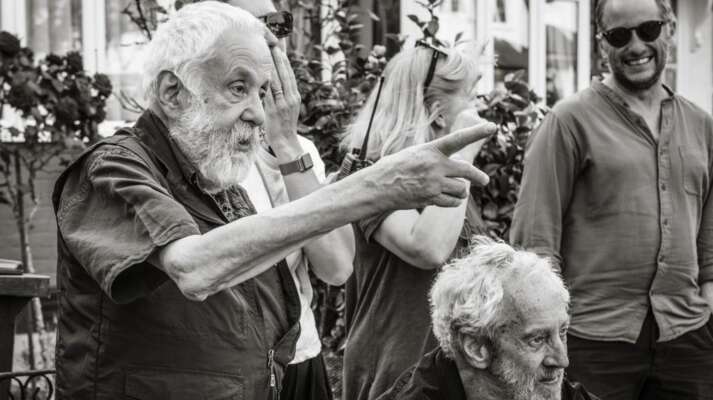War Is...
Variations from Paths of Glory to EYE IN THE SKY
War Is...
Written by Peter Bowen
EYE IN THE SKY | Factoring in our Humanity
Ever since 1898, when Stuart Blackman and Albert E. Smith shot the 90-second propaganda film, Tearing Down the Spanish Flag, on the roof of their New York City studio, war films have been a staple of cinema. While many films revel in the action and pageantry of battle, others take a deeper look at the complex conditions that push nations into war and the impossible moral questions raised by such conflicts. Gavin Hood’s EYE IN THE SKY brings the war film into the 21st century with its suspenseful look at how the international fight against terrorism is being waged by new military technologies like drones. But it also dares to consider the human factor in our rush to deploy these new weapons. “You can debate the political and technical factors that influence the use of drone strikes as much as you like, but I ultimately want this film to remind us of the need for compassion no matter where we are in the world,” says Hood. “If a decision has to be made in a very difficult situation like the one presented in EYE IN THE SKY, I hope that decision would be made with respect for one another as human beings.” Moving across the globe, as well as from the battlefield to the boardroom, EYE IN THE SKY surveys all the elements (political, diplomatic, technical, and strategic) that factor into a single military action. In the following piece, we consider other thoughtful films that put the subject of war in their crosshairs.
 Paths of Glory | The Madness of Power
Paths of Glory | The Madness of Power
After his stylish noir The Killing, Stanley Kubrick turned his focus to making a war film with his 1957 Paths of Glory. For Kubrick the filmmaker, war poses an unparalleled dramatic laboratory. “The soldier is absorbing because all the circumstances surrounding him have a kind of charged hysteria,” explains Kubrick. “For all its horror, war is pure drama, probably because it is one of the few remaining situations where men stand up for and speak up for what they believe to be their principles." Based on Humphrey Cobb’s 1935 novel of the same name, which Kubrick had read as a youth, Paths of Glory tells the story of a French colonel during World War I whose biggest battle is with a self-serving general and a corrupt government. Cobb’s tale was based on a real World War I event in which a French commander, General Géraud Réveilhac, had four corporals executed for refusing to fire on their fellow soldiers. Crime novelist Jim Thompson’s script captures both the horrors of battle and the absurdity of war. After a failed and deadly assault on a German encampment called “Ant Hill,” General Mireau (George Macready) orders other infantrymen to fire on the war-torn soldiers incapable of continuing the futile siege. When his troops refuse to shoot down their brothers in arms, Mireau orders three corporals to be court-martialed for cowardice, a charge whose punishment is death. After being picked up by MGM, the project was nearly shelved when the studio went through a change of management. Then Kirk Douglas showed up as its hero (both in front of and behind the camera). Not only did Douglas agree to star as the film’s lead, Colonel Dax, the man who attempts to defend the indicted three soldiers, but he also helped finance it. As the head of Bryna Productions, Douglas used his own star power to convince United Artists to pony up the film’s $900,000 budget, with $350,000 being paid directly to him as the film’s star. Shooting in Bavaria, Kubrick and his art director Ludwig Reiber transformed the area’s bucolic alpine pastures into a harrowing, burnt-out no-man’s land littered with bomb craters and traversed by trenches. For extras, Kubrick employed local policemen to play French soldiers, a move that originally created problems when the eager and orderly German cops could not comprehend how to appear as disheveled, war-weary French infantrymen. When Paths of Glory premiered in December 1957, it proved a revelation to many, both as proof of Kurbrick’s visual genius and as a testament to what war pushes men to do. “The close, hard eye of Mr. Kubrick's sullen camera bores directly into the minds of scheming men and into the hearts of patient, frightened soldiers who have to accept orders to die,” wrote The New York Times’ Bosley Crowther. Sir Winston Churchill vouched for the film’s authenticity. The French government, however, was less than pleased with such a disturbing portrait of their military. Not only did they seek to have it withdrawn from the 1958 Berlin film festival, but the film was not released in either Switzerland or France until the 1970s.
 Dr. Strangelove or: How I Learned to Stop Worrying and Love the Bomb | Tragedy Into Farce
Dr. Strangelove or: How I Learned to Stop Worrying and Love the Bomb | Tragedy Into Farce
When Karl Marx noted “History repeats itself, first as tragedy, second as farce,” he probably wasn’t thinking about Stanley Kubrick’s 1964 Dr. Strangelove or: How I Learned to Stop Worrying and Love the Bomb. But hisformula neatly describes the film’s evolution. At the end of the 1950s, when Kubrick was interested in making a film about the nuclear arms race, he optioned Peter George’s Red Alert. The author explains in his forward that his novel tells “a pitiless, cruel story, because pitilessness and cruelty are inherent qualities of battle, and especially a battle fought with modern nuclear weapons.” By the time Kubrick and his screenwriter, Terry Southern, tried to use George’s plot to incorporate the political reality of how a nuclear strike might occur, their tragedy had turned into a farce. "My idea of doing it as a nightmare comedy came in the early weeks of working on the screenplay," Kubrick later said. "I found that in trying to put meat on the bones and to imagine the scenes more fully, one had to keep leaving things out which were either absurd or paradoxical in order to keep it from being funny; and these things seemed to be close to the heart of the scenes in question." After the slightly demented US Air Force Brigadier General Jack D. Ripper (Sterling Hayden) launches an unprovoked nuclear strike against the USSR, America is thrown into crisis in which various political and military figures attempt to find a way to resolve the inevitable conflict, especially after they learn their attack will set off a Russian doomsday machine guaranteeing total nuclear annihilation. This terrifying scenario, however, quickly turns into a comedy of errors with the help of the film’s remarkable cast, most notably Peter Sellers, who plays three different characters. Many of the film’s best performances, however, were not intentional. Slim Pickens, who plays the cowboy pilot who rides a nuclear payload into Russia, was kept in the dark about his character’s comic nature. And George C. Scott was coaxed into delivering over-the-top performances by being reassured they were just practice runs. While audiences got the joke, not everyone thought it was funny. The New York Times reviewer Bosley Crowther labeled the film “the most shattering sick joke I've ever come across,” adding that the he was “troubled by the feeling… of discredit and even contempt for our whole defense establishment.” The film certainly made the Defense Department defensive, who later went on to make their own short film SAC Command Post (which was ultimately shelved) to demonstrate how secure America’s nuclear arsenal actually was. In end, the film’s slapstick view of war served to both enthrall and enrage nearly everyone. "Conservatives will find it subversive, liberals will find it irresponsible, utopians will find it bleak, humanitarians will find it inhuman,” notes Robert Burstein in the New York Review of Books. “But it also releases, through comic poetry, those feelings of impotence and frustration that are consuming us all; and I can't think of anything more important for an imaginative work to do."
 Fail Safe | The Impossible Made Probable
Fail Safe | The Impossible Made Probable
In October 1962, as Americans were fixated on news broadcasts updating them on the Cuban Missile Crisis, Saturday Evening Post serialized a new novel by two political scientists, Eugene Burdick and Harvey Wheeler, called “Fail Safe.” The book’s terrifying premise showcased, much like EYE IN THE SKY, a emerging military technology with few ethical or political guidelines on how to use it. When a machine malfunction sends a plane with a nuclear warhead speeding towards Moscow, the president, his chiefs of staff, and various advisors are confronted with the very real possibility of a thermonuclear war. After snapping up the rights to the book, film executive-turned-producer Max E. Youngstein turned to Sidney Lumet to direct and Walter Bernstein to write the screenplay. Unlike Dr. Strangelove, Fail Safe maintains a somber, nightmarish tone with the morally decent President (Henry Fonda) and his generals grappling with how best to handle this new technology that now threatens to wipe out more than half the world. Only Groesteschele (Walter Matthau) comes anywhere close to a villain. Based on real-life political scientist Herman Kahn, Groesteschele’s cold, analytical talk of statistical probability and acceptable losses rings inhumane in the shadow of a potential apocalypse. Praising the film in The New York Times, Bosley Crowther argues, Fail Safe “does not make its characters out to be maniacs and monsters and morons. It makes them out to be intelligent men trying to use their wits and their techniques to correct an error that has occurred through overreliance on the efficiency of machines.” The military themselves, however, were not as favorable in their review. For Air Force chief of staff General Curtis LeMay, “The incidents in Fail Safe are deliberate lies!” In a 2014 New Yorker article, Eric Schlosser rebuts that claim, noting that films like Dr. Strangelove and Fail Safe“provided a far more accurate description of the dangers inherent in nuclear command-and-control systems than the ones that the American people got from the White House, the Pentagon, and the mainstream media.”
 Seven Days in May | The Coup d’Etat
Seven Days in May | The Coup d’Etat
If EYE IN THE SKY highlights the complex negotiations that occur between the military and government, John Frankenheimer’s 1964 political thriller Seven Days In May imaginatively plots a situation in which that relationship completely breaks down. After his success with The Twilight Zone’s metaphysical realm, Rod Serling was hired to adapt Fletcher Knebel and Charles W. Bailey II’s successful 1962 novel of an alternative political future. Knebel, a political journalist at the time, was inspired by an exchange he overheard in which several generals were mocking President John F. Kennedy for his weakness during the Bay of Pigs. “Why did not the military attempt to seize power in America?” thought Knebel. “Coups were common elsewhere in the world.” Set in the 1970s, the film follows the political fallout after the President (Fredric March) signs a nuclear disarmament treaty with the USSR. In response, the military leaders plan a seven-day take over of the government. Although set in the future, the tale incorporates many characters based on real-life contemporary figures. The coup’s leader, General James Mattoon Scott (played by Burt Lancaster), was inspired by the real-life Major General Edwin Walker, an ultra-conservative segregationist who once accused Eisenhower of being a communist and later distributed “Wanted for Treason: JFK" handbills. Acutely aware of the story’s political resonance, Kennedy opened up the White House to the filmmakers. Suspecting the military would be less obliging, Frankenheimer and his team covertly shot Kirk Douglas (Colonel Jiggs Casey) entering and exiting the Pentagon from a disguised truck on the street. While many now find the story’s military coup unrealistic, the scenario proved entirely plausible to both the public and press when it was released. The New York Times stated, “Considerably more than melodrama and sensationalism are contained in its not too farfetched speculations.” Indeed the premise was so realistic that one member of the House of Representatives questioned if the film should not be labeled as fiction before it was distributed to foreign countries.
 In the Loop | The Politics of War
In the Loop | The Politics of War
For the last two decades, Armando Iannucci has been an unstoppable comic force in Britain. After creating a series of faux news and documentary programs, like The Day Today and I'm Alan Partridge (starring Steve Coogan), he raised his comic eyebrow to consider politics in the sitcom “The Thick of It,” a popular show reveling in the absurdities of day-to-day policy making. In 2009, he took “The Thick of It”’scomic style, as well as many of its characters, to an international level with his feature film In The Loop. In The Guardian, Iannucci recounts the film’s simple pitch: "I want to make a comedy about what happens when the US president and the British PM are very keen on a course of military action in the Middle East that no one else thinks is a good idea. We watch everyone under them wonder what to do." The story follows a minister of international development (Tom Hollander) as a few misspoken comments push him into the middle of an international political melee over Britain’s willingness to go to war. Although the film goes nowhere near a battlefield, the war of words between various figures––including James Gandolfini as a dovish general––demonstrate how easily the inanity of politics can be transformed into the insanity of war. “Even among the saner characters, there seems to be hardly any deep awareness that war means human misery and actual people being dead,” points out the San Francisco Chronicle’s Mick LaSalle. “These functionaries are lost in the fog of government, incapable of seeing past their petty grievances and career concerns, as they contribute in tiny ways to the creation of a disaster.”
 American Sniper | A Personal Hell
American Sniper | A Personal Hell
To make the insanity of war personal, Clint Eastwood’s American Sniper zeroed in on the very intimate and real story of Chris Kyle (played by Bradley Cooper). Adapted from Kyle’s own memoir “American Sniper: The Autobiography of the Most Lethal Sniper in U.S. Military History,” the film goes beyond the scope of Kyle’s particular story to incorporate the shocking end of his life. In 2013, a year after his memoir was published, Kyle was shot to death on a shooting range in Texas by a veteran whom Kyle was attempting to help with his PTSD. In tracing out Kyle’s remarkable achievement as the army’s top sniper during the Iraqi war, Eastwood’s film also reveals the emotional scars inflicted by the conflict, wounds that show up when Kyle returns home to his wife (Sienna Miller) and family. When released the film provoked a range of reactions. Some read the film’s straightforward narrative tone as evidence that Eastwood was supporting the Iraqi war. But the filmmakers argued quite the opposite. “We didn't set out to explore the archetype of war; we set out to explore the archetype of the warrior,” screenwriter Jason Hall told Rolling Stone. In Deadline, Hall remembers the effect of meeting Kyle for first time: “You could see it, how that war took something drastic from him, a piece of his humanity. What he did. What he saw. What he lost. Whatever happened over there, it took a piece of him.” It was this condition Eastwood claimed he was trying to capture. “You can see …when he visits a psychiatrist and has to talk to him and the psychiatrist says did you do anything along the way over there that you maybe or you felt you shouldn’t have. And you could tell by the look on his face that yeah, he's got some regrets,” Eastwood told The Hollywood Reporter. The film’s almost journalistic approach towards the war’s violence may have proved its greatest asset, as the film appeal to a range of audiences for different reasons. For veterans, it was a powerful testament to the sacrifices soldiers face. For critics, it captured the madness of violence. What quickly became apparent to all was the film’s massive box office appeal, shooting up to become the highest grossing domestic film of 2014, as well as garnering six Academy-Award nominations, including Best Picture and Best Actor.


